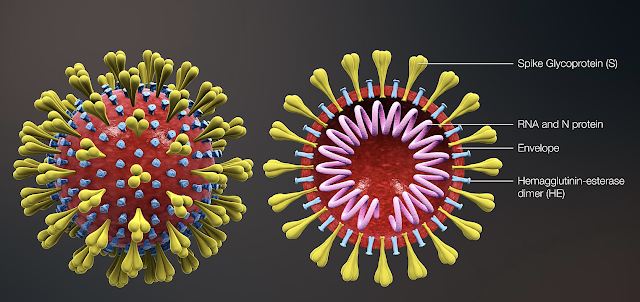All diseases, including typical SARS, begin after a person has contact with pathogenic microorganisms. And if many of them are studied and with proper treatment do not pose a danger, then others eventually acquire various mutations that people learn to deal with directly during the course of the disease. Sometimes in these cases we can talk about epidemics.
Coronaviruses that cause disease in mammals: cats, pigs, cattle and birds, are mutable viruses. Currently, 40 species of coronaviruses with different RNA compositions are known. They are grouped into 2 subfamilies. Such variability and a large number of variations makes the coronavirus dangerous for humans.
The etymology of the name lies in the appearance of pathogenic cells. Because of the protrusions on the surface of the spikes, viruses look like a crown.
Detection History and Epidemiology
For the first time, the coronavirus was isolated from the SARS virus in 1965. For almost 40 years, the diseases caused by it did not attract people's attention. But in 2002 in China, 775 people died from the acute respiratory syndrome caused by the SARS-CoV coronavirus. More than 8 thousand Chinese people were infected with the virus, which means that the mortality rate of a mass outbreak was 9.6%, in this case every 10th infected person died.
Almost 10 years after the full recovery of citizens of China and neighbouring countries, the virus was silent. But in 2012, a new outbreak of Middle Eastern respiratory syndrome occurred. Specialists sought complete stagnation of the MERS-CoV virus a little over a year. In 2015, the same MERS-CoV intensified in South Korea. He claimed the lives of 33 patients, with a mortality rate of just over 18%.
In December 2019, the inhabitants of the most densely populated Far Eastern country were again struck by a previously unknown coronavirus. According to the logic of past years, the new pathogenic RNA carrier was named 2019-nCoV. 2 months after the discovery of the first victims of 2019-nCoV, the number of infected people approached 9 thousand, and more potential patients are under observation. 217 deaths were registered, almost the same number of people successfully cope with the disease.
Symptoms of infection
The clinical manifestations of coronavirus infection are similar to other acute respiratory infections, bronchitis, pulmonary pneumonia, and even gastroenteritis. Having another RNA, he provokes these diseases, and he himself begins to depress the immune system. In the process of synthesis of immune cells with coronavirus, defense mechanisms cease to recognise the infection, and, accordingly, the body does not fight it on its own. Immune support after recovery is completely absent for a short time, so a person can again catch this virus or any other and again seriously ill.
The most dangerous for living things is considered betacoronavirus.
The microorganism has many distribution paths, from dusty to contact. 80% of people are carriers of specific contact antibodies, so you can get infected with coronavirus even in open air.
At the first sign of an epidemic, quarantine cities should be immediately closed, since at the slightest delay the virus will spread outside the source territory, which happened during the outbreak in 2019. Today, isolated cases of the disease, in addition to China, were detected in 20 neighbouring and sufficiently remote states from each other.












